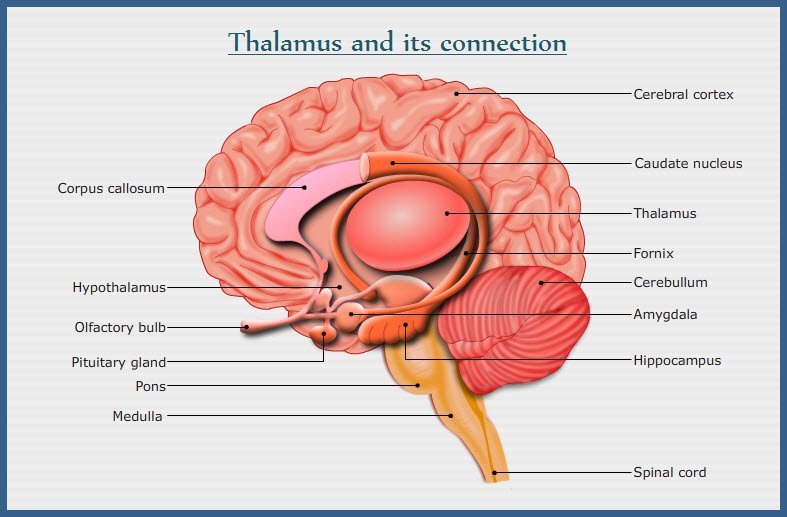TABLE OF CONTENTS
Thalamus and Functions of it
Thalamus
Thalamus is a sensory relay station and is important in motor control and play a major role in control of cerebral excitability.
Located deep within the brain near the basal nuclei forms the part of diencephalon. Represented by large grey mass related medially to the third ventricle and at the base of lateral ventricle.
- Specific projection system: Receives specific afferents from the periphery, which are processed in the thalamus and relayed to specific areas of the cortex for conscious perception.
- Lateral geniculate body: Receives the visual signals through optic tract and projects the outputs to the visual or the striated area of the cortex.
- Medial geniculate body: Receives the auditory signals through the cochlear nerve and projects the efferents to the temporal lobe of the cortex.
- Ventrobasal complex: Receives sensory impulses through medial lemniscus, spinothalamic and trigemina0l nerve and projects its output signals to the somesthetic and gustatory areas of the cortex.
- Posterior nuclear group: Receives the pain sensations through medial lemniscus and spinothalamic tract and projects them to the cortex.
- Ventrolateral nuclei: Acts as a motor relay station that receives the input signals from the basal ganglia and cerebellum and projects the efferents to the motor cortex.
- Anterior nuclei: Receives input signals from the mammillary body of the hypothalamus and projects the efferents to limbic cortex and cingulate gyrus of the cortex.

Functions of Thalamus
- Thalamus mediates connections between cerebral cortex, basal ganglia, hypothalamus, cerebellum, brainstem, reticular formation, and spinal cord. Physiologically thalamus can be considered to have three systems.
- Specific projection systems-transmits information to and from cortex.
- Nonspecific or diffused projection system-has widespread action on cortex.
- Acts as pacemaker that regulates the cortical activity.
- Thalamus acts as a synaptic integrating centre for preprocessing of all sensory information to cortex except olfaction.
- Thalamus screens the sensory impulses to appropriate areas of the somatosensory cortex.
- Thalamus is capable of recognizing crude awareness of various sensations, but unable to identify and distinguish strength, location, and intensity.
- Somesthetic sensory impulses reach the thalamus through medial, spinal lemniscus to posteroventral nucleus of the thalamus.
- Taste fibers are relayed in arcuate nucleus.
- Arousal, alert, or wakefulness is maintained by part of the thalamus due to the fibers from forebrain and midbrain reticular formation and hypothalamus.
- Act as higher centre for crude sensation and of pain and temperature.